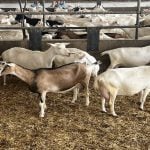World wheat production will have to increase at least 60 percent in coming decades, and genetically modified varieties are inevitably part of the solution, says a leading Australian breeder.
Peter Langridge, chief executive officer of the Australian Centre for Plant Functional Genomics in Adelaide, told a Genomics Canada conference last week that population growth will require significant increases in production.
Yet land restrictions, limited water resources and a growing privatization of wheat research make the goal difficult to achieve.
“These are exciting times, but it also is a worrying time,” he told the conference Nov. 28.
Read Also

South American soybeans will have less impact on canola
South American production will, as usual, affect the global oilseed market, but Canadian canola is on the outside looking in until it can get China back or find alternative buyers.
In a later interview, Langridge said public resistance to GM wheat is “an obvious road block.”
However, he said many companies and countries continue to work on the technology, which must be part of the solution if the production increase goals are to be met.
“I simply don’t see any other way to meet that challenge,” he said. “There has to be GM wheat at some point.”
Hybrid wheat varieties can also be part of the solution, he added.
The University of Adelaide re-searcher also suggested that the introduction of GM wheat will likely not happen first in the developed world but in a country such as China or India, where food demands are high and growing.
“China has invested $5 billion in developing GM wheat, and when it is a choice between hunger or GM wheat, it will be introduced,” he said. “And if China introduced GM wheat, India will follow.”
Langridge said similar consumer and environmental resistance was seen decades ago when new grain varieties and production practices were introduced into India in what came to be known as the Green Revolution.
“There was huge controversy,” he said. “It ended up saving 200 million lives, and not many decisions in history can be said to have had that impact.”
When asked about the potential impact of ending the CWB’s wheat innovation and breeding, Langridge said there was an impact on the direction of wheat breeding in Australia when that country’s single desk wheat board was abolished.
He said the Australian Wheat Board acted as a central source of information about what wheat varieties the markets wanted.
That public market information-clearing-house has been lost with the privatization of the board, and companies now direct their research to products they think will sell and make money.
“What has happened in Canada is really déjà vu in Australia,” he said without stating a position on whether it was a good move.
“It has affected our breeding program. There now is a disconnect between our breeding efforts and what the market needs.”
Langridge said genetic work with wheat is one of the most complex tasks in his business.
Work continues on unraveling the wheat genome, but with 100,000 genes in wheat, it is six times larger than the human gene.
“Genomics have a huge role in future advancements in the wheat industry, but this is a hugely complicated endeavour,” he told the conference.














